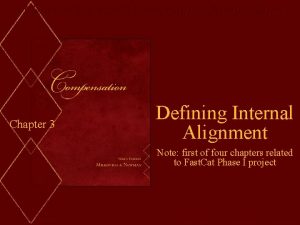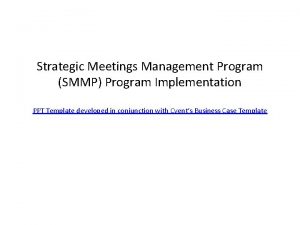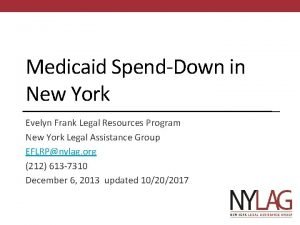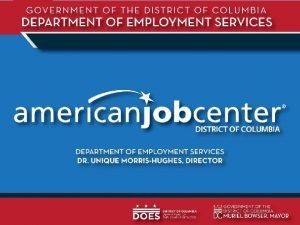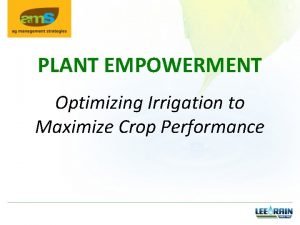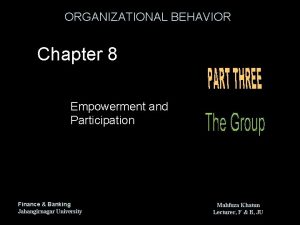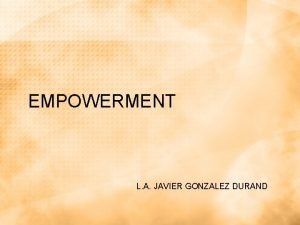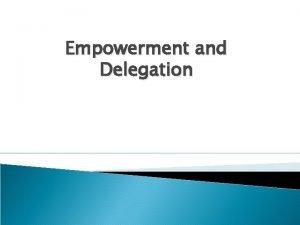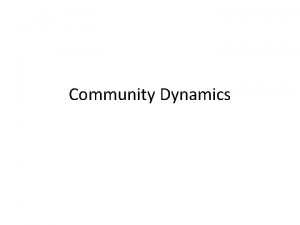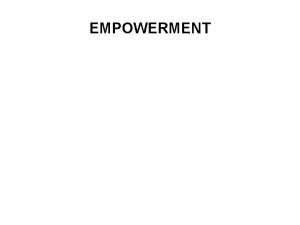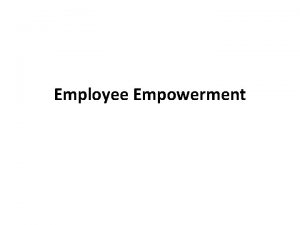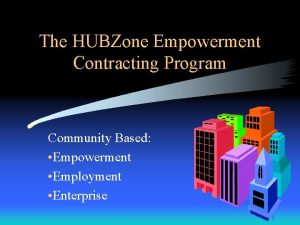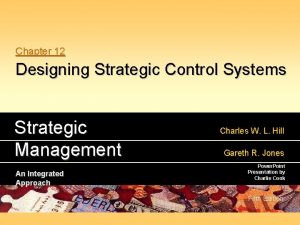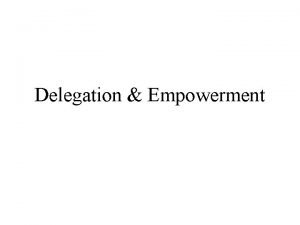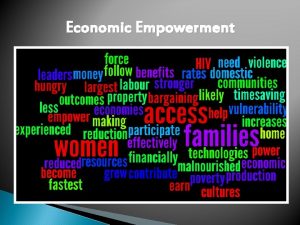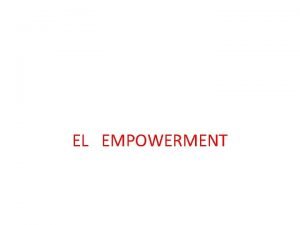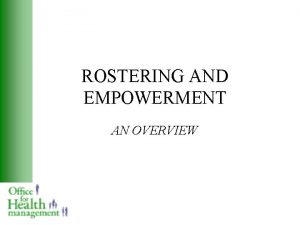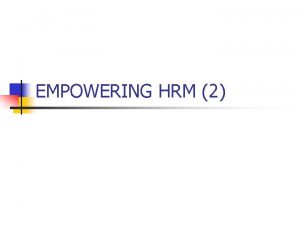DESIGNING A STRATEGIC LEGAL EMPOWERMENT PROGRAM Legal Empowerment


















- Slides: 18

DESIGNING A STRATEGIC LEGAL EMPOWERMENT PROGRAM Legal Empowerment Leadership Course Budapest, December 2 -7, 2018

Overview Defining the Problem to be Addressed by a LE Program Environment and Institutional/Operational Status of the Implementing Organization Case Study Analysis I Planning the LE Program Response Additional Planning Considerations Defining, Measuring, and Monitoring Results Knowledge Sharing Case Study Analysis II

Participant Problem Statements Collective Action Class actions Media campaign to propel government action Policy advocacy—rights of persons in criminal detention Data/Monitoring and Evaluation Efficient data collection and management Funding and Sustainability Community ownership of legal empowerment programs Raising necessary resources—community investment, donor investment Establish sustainable structure and activities—reduce donor dependency Issues Rights, security, and voice of women: gender-based violence; women’s relationship to power, decision making, resource allocation, and economic opportunity People with disabilities—including women and children Countering opposition to legal empowerment from the formal justice system, legal professionals, and others

Participant Problem Statements Paralegals Bridge between communities and legal professionals Networks of women paralegals; land tenure of farmers; reduce the environmental consequences of extractive industries Partnerships among communities, NGOs, and government agencies and officials Connecting law students in different countries Productively engage government and international agencies Scale Taking existing programs to larger scale National legal awareness programs Technology Apply cutting-edge technology—including online case management systems Sustainability and Resources Community ownership, raising necessary resources, sustainable structure and activities —reduce donor dependency

Strategic Legal Empowerment Program Design Some Features of a Strategic Legal Empowerment Program: Informed by the experience and engagement of the vulnerable populations that the program is intended to empower Design integrity—research and data informed, options weighed Informed by political and other realities--technically sound and politically feasible Founded on trust relations and partnerships Capably led and staffed Adequately resourced—realistically budgeted Monitored, analyzed, refined, evaluated, and reported Sustainable Documented and disseminated Experiment and learning are especially important

Defining the Problem to be Addressed Core challenges, constraints, or opportunities affecting vulnerable populations that the LE program aims to address? —Possible and useful to define? Analyzing causes and contributing factors as experienced by vulnerable populations and understood by prospective activists or objective observers—Common or divergent understanding? Implications for the poor, women and girls, key populations, or other especially vulnerable groups?

Defining the Problem to be Addressed Characterizing the challenge with reference to illustrative organizing categories: o First-Order Contraints: Inequities rooted in traditional societal norms, structures, and biases; lack of knowledge on the part of citizens and public officials; lack of economic independence; vulnerable populations face problems grounded in law, legal rights, and impunity, with limited understanding and expectations. o Middle-Order Contraints: Complex and inequitable power relationships; formal justice system constraints; quality of informal justice alternatives; sound laws, weak implementation; inconsistency between formal law and traditional values and practices. o Highest-Order Contraints: Factors beyond the control of individuals affect vulnerable communities and populations at large—lack of citizen voice in law and policymaking; individual problems addressed but broader benefits fail to register at political/policy level; communities depend on legal support with little reflection on capacity to take the law into their own hands.

Defining the Problem to be Addressed Locus of the issue: Local, regional, or national-level issue? Taking account of underlying political, sociocultural, and other dynamics—Are all legal rights and deprivation of voice issues ultimately political? Who will benefit from the desired action, change, or law reform? Are they potential champions? Who is threatened or stands to lose? How will they respond? What incentive factors can potentially motivate opponents to change their position?

Program Environment Present relationship between the LE implementing organization and persons affected by the core issue Are there existing trust relations, or must these first be established? Present relationship of the implementing organization with government agencies/officials or other stakeholders who have a significant role in the issue or its resolution?

Status and Institutional/Operational Context of the Implementing Organization Status of the LE implementing organization—local, regional, national? Dedicated legal service provider or a broader development organization? Does it work independently or through a partnership network? Is it a member of a coalition of likeminded organizations? Scaling-Up: Is a grassroots-focused organization positioned to operate at a regional or national level—Beyond its existing capacity or focus? Implications for the integrity of its work?

Case Study Exercise I Can the Pinogrigia challenges be reduced to a single core issue? What tools and resources can be utilized to achieve a deeper understanding of the circumstances of women and girl in remote regions of Pinogrigia? What combination of constraints should Women Now take account of in developing a LE strategy to support the PWGA? Are certain constraints more significant or challenging than others? Which government agencies and officials are most likely to support the PWGA and which are likely to oppose its implementation? How can a LE strategy take account of this tension in mobilizing champions and managing spoilers? How should Women Now scale-up its role and work to support the PWGA? How can Women Now take optimal advantage of its existing partner network? How can Women Now establish trust relations with the Pinogrigia National Police, judges of PWGA special tribunals, public prosecutors, and other stakeholders?

Planning the Legal Empowerment Response Narrowing the scope of LE approaches: lower, middle, and highest-order strategies and program activities Potential types of activity: o o Basic education and awareness raising—targeted, population-wide Formal and informal legal support Higher-order advocacy or law reform? Combination of approaches— concurrent or sequenced? Timeline: Urgent action or sequential steps and milestones?

Planning the Legal Empowerment Response Prospective actors and interlocutors: o o Weighing the choice of strategic program options o Who are the key implementing actors and partners? What is their relationship with vulnerable populations? Scope for experiment? Relevant experience and lessons learned that may inform the strategy?

Planning the Legal Empowerment Response Taking a LE program to scale Scope for practical division of labor among implementing organizations? Articulation of strategic approach o Theory of change and other tools Sequence of activities Work plan and timelines

Additional Planning Considerations Women and gender considerations Program leadership and succession considerations Potential adaptive management approaches Ownership and sustainability Prospective public-private partnerships Multi-stakeholder approaches Engaging champions and engaging or managing spoilers

Defining, Measuring, and Monitoring Results Establishing baselines from which to monitor and assess change over time Monitoring and evaluation plan—Striking a balance between cumbersome and overly simple Adaptive management and other iterative approaches M&E tools—contribution analysis, strategy testing

Thought Leadership and Knowledge Sharing Broader relevance of a LE approach Potential shared records of experience

Case Study Exercise II What program activities should Women Now to take to support the Protection of Women and Girls Act (PWGA)? Single or multiple interventions? At what level(s)? Sequenced or concurrent? Awareness raising strategies? Higher-level advocacy and law reform strategies? Informal justice approaches—Paralegal networks? Community -based dispute resolution? How can Women Now effectively work with different public sector stakeholders? —PWGA tribunals? Pinogrigia National Police? Public prosecutors? Ministry of Women’s and Children’s Affairs? Potential role in convening multi-stakeholder dialogue and cooperation? Factoring financial resource and sustainability considerations? Convention or innovation in strategic articulation of the LE program and M&E tools? Baseline data collection? Potential thought leadership and knowledge sharing contributions?
 Internal alignment pay structure
Internal alignment pay structure Designing marketing programs
Designing marketing programs Strategic fit vs strategic intent
Strategic fit vs strategic intent Strategic substitute
Strategic substitute Strategic management and strategic competitiveness
Strategic management and strategic competitiveness Strategic analysis and choice in strategic management
Strategic analysis and choice in strategic management Strategic meetings management strategy
Strategic meetings management strategy Ssop navy
Ssop navy Strategic sealift officer program
Strategic sealift officer program Civilian strategic leader program
Civilian strategic leader program Primerica prepaid legal
Primerica prepaid legal Evelyn frank
Evelyn frank Gnc knoxville tn
Gnc knoxville tn Project empowerment orientation registration
Project empowerment orientation registration Plant empowerment the basic principles
Plant empowerment the basic principles Empowerment and participation in organizational behavior
Empowerment and participation in organizational behavior Ejemplo de empowerment en claro
Ejemplo de empowerment en claro Difference between delegation and empowerment
Difference between delegation and empowerment Community processes dynamics and empowerment
Community processes dynamics and empowerment
